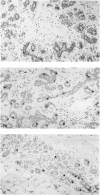Abstract
The proliferative activity of normal acinar and ductal breast epithelial cells was studied by in vivo labeling with 5-bromodeoxyuridine (BrdUrd) in 26 cases with concurrent breast carcinoma. The BrdUrd-labeled cells were recognized in histologic sections of paraffin-embedded tissue, using an anti-BrdUrd antibody and an immunoperoxidase reaction. The percentage of BrdUrd-labeled cells showed great variability for both acinar (0% to 2.66%; mean, 0.70%; standard deviation [SD], 0.80%) and ductal cells (0% to 1.99%; mean, 0.51%; SD, 0.57%). The fraction of proliferating epithelial cells declined with the age of the patients and was significantly higher in premenopausal women (1.16% +/- 0.85% for acinar and 0.94% +/- 0.60% for ductal cells) as compared with the postmenopausal women (0.27% +/- 0.46% for acinar and 0.17% +/- 0.22% for ductal cells), P less than 0.01 for acinar and P less than 0.001 for ductal cells, respectively. In some patients, great variability in distribution of proliferating acinar and ductal cells among different lobules and ducts was observed. No difference was found in the number of proliferating acinar and ductal cells situated near or far from their corresponding tumors. No correlation was seen between cell proliferation of normal acinar or ductal cells and cell proliferation of the respective tumors.
Full text
PDF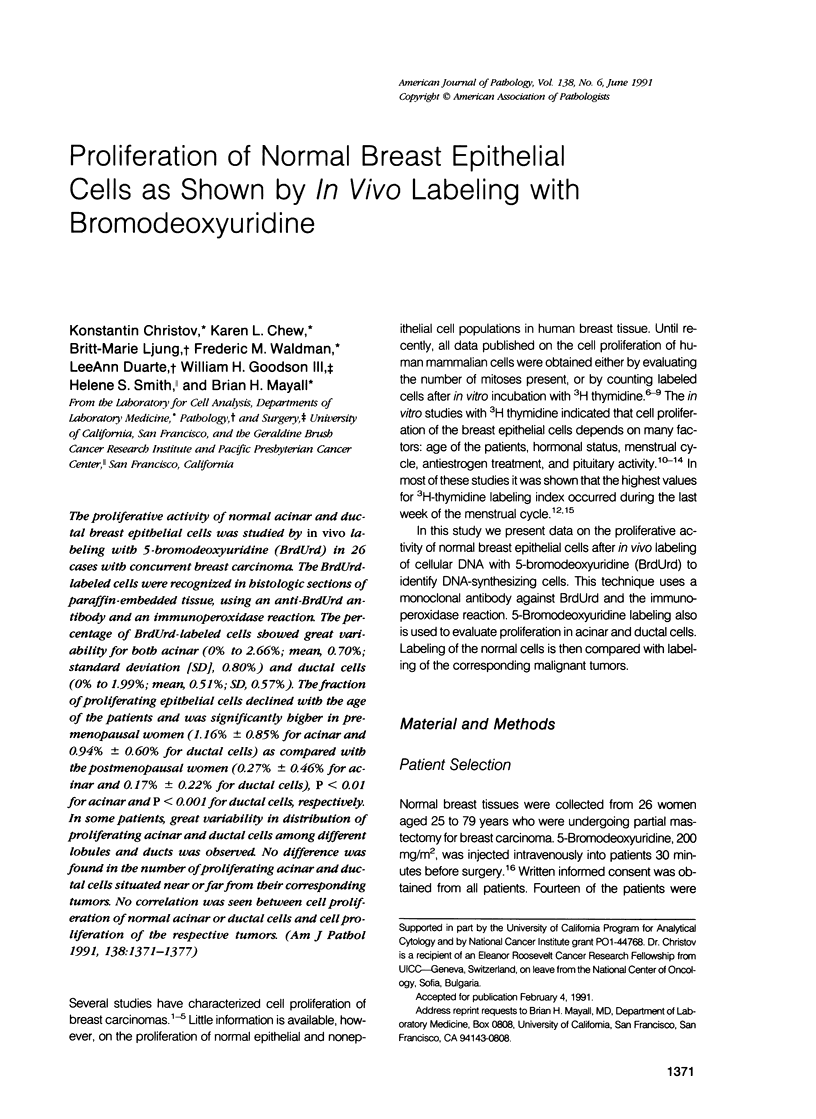
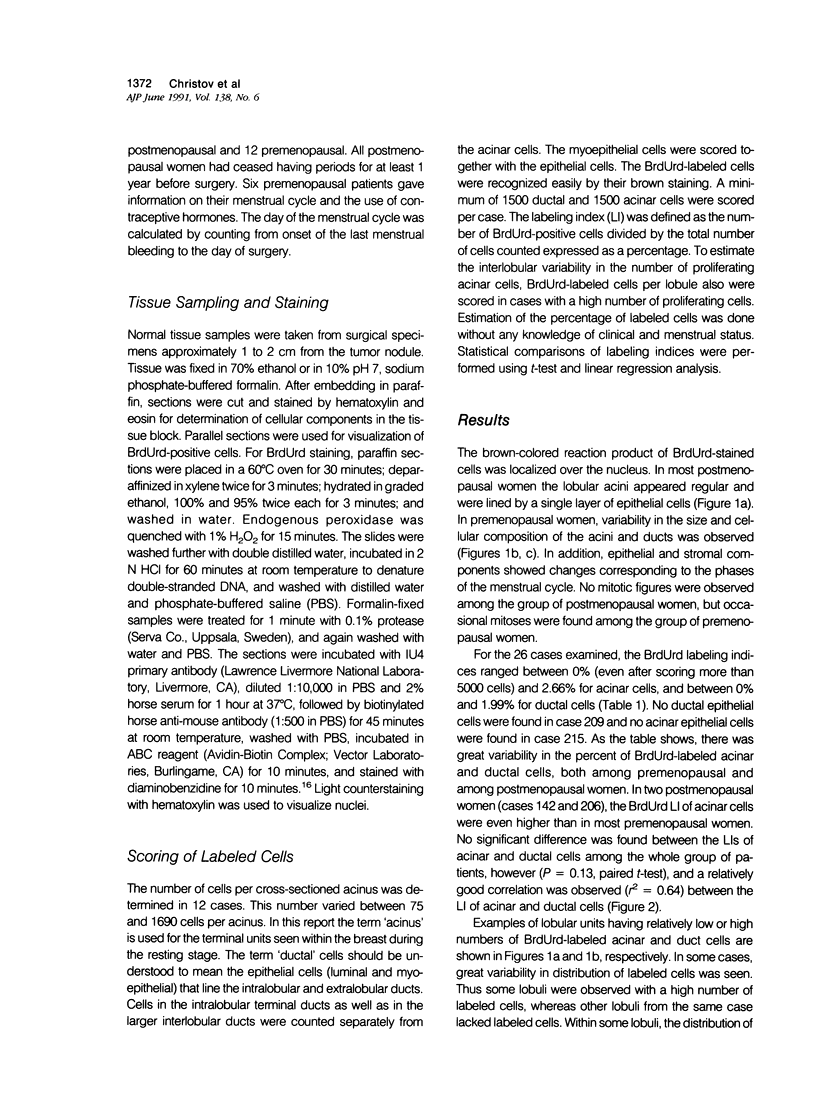
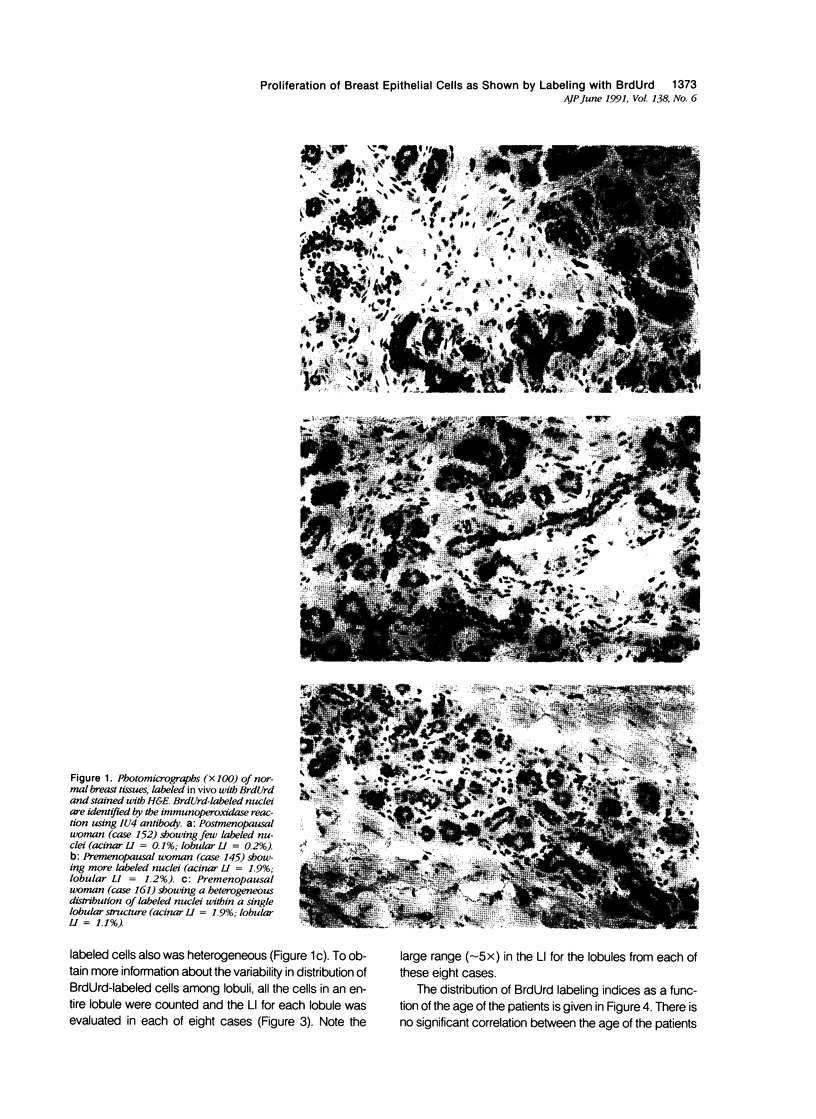
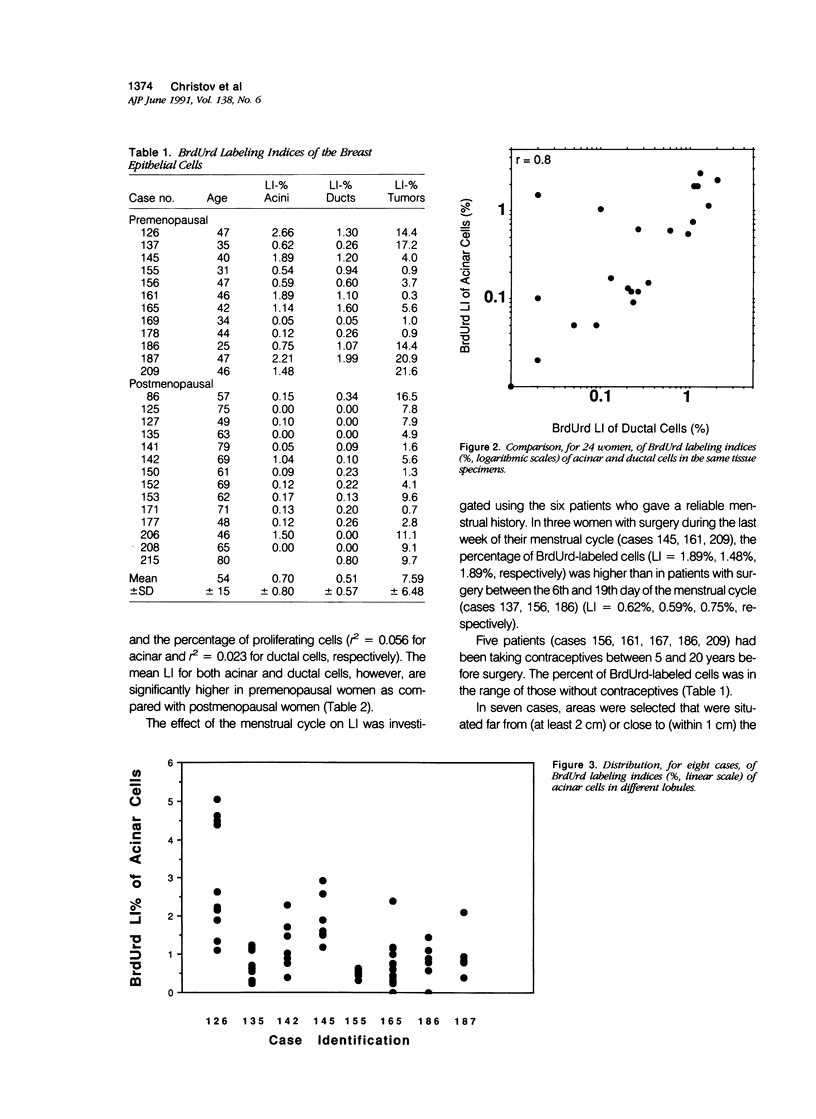
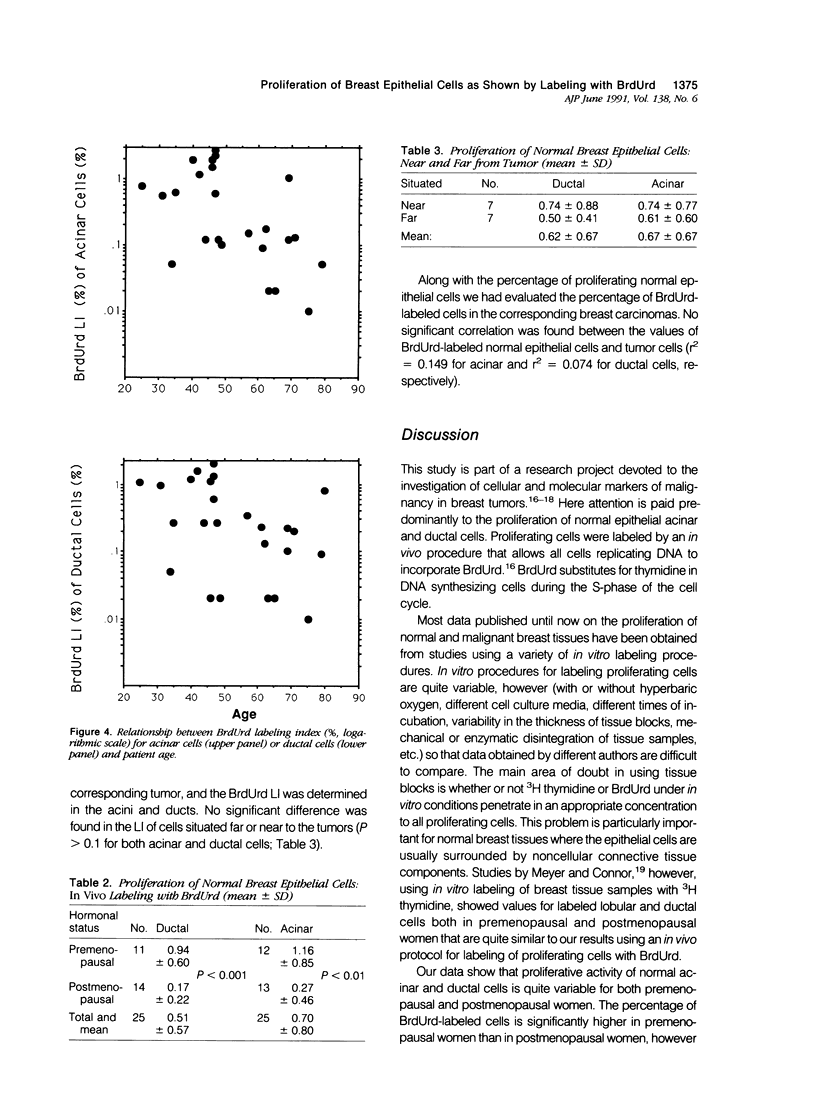
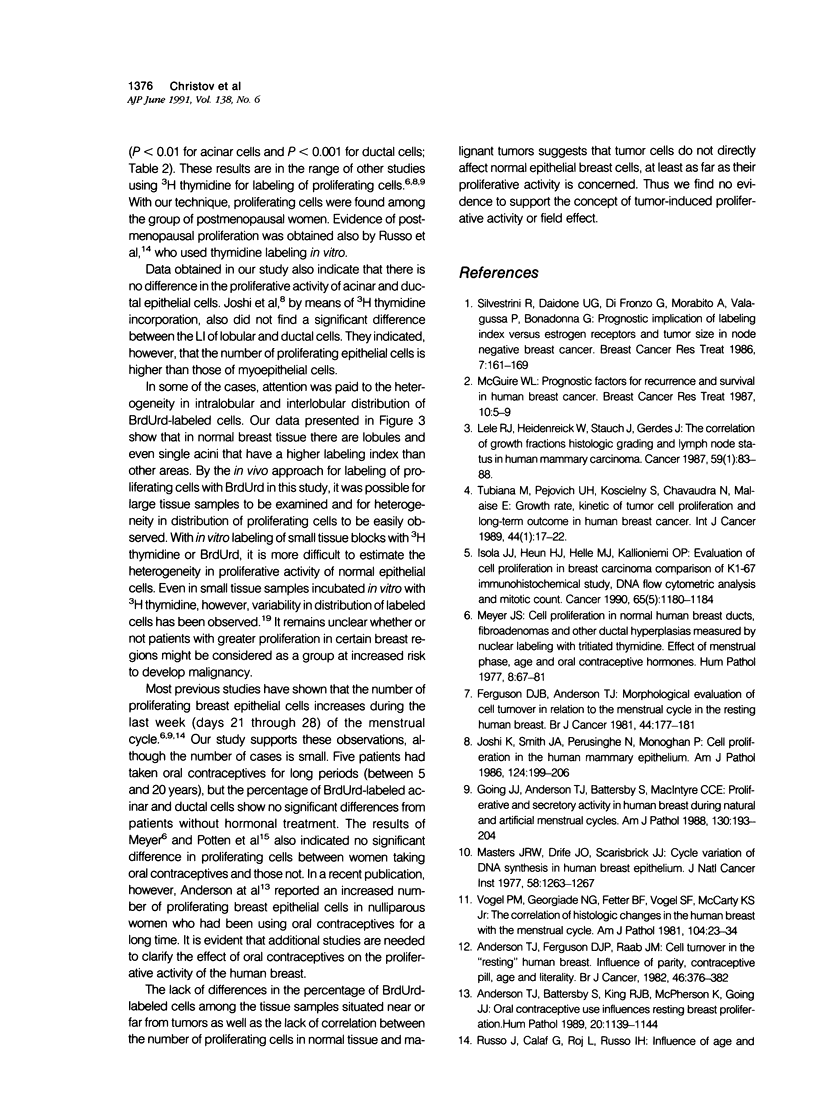
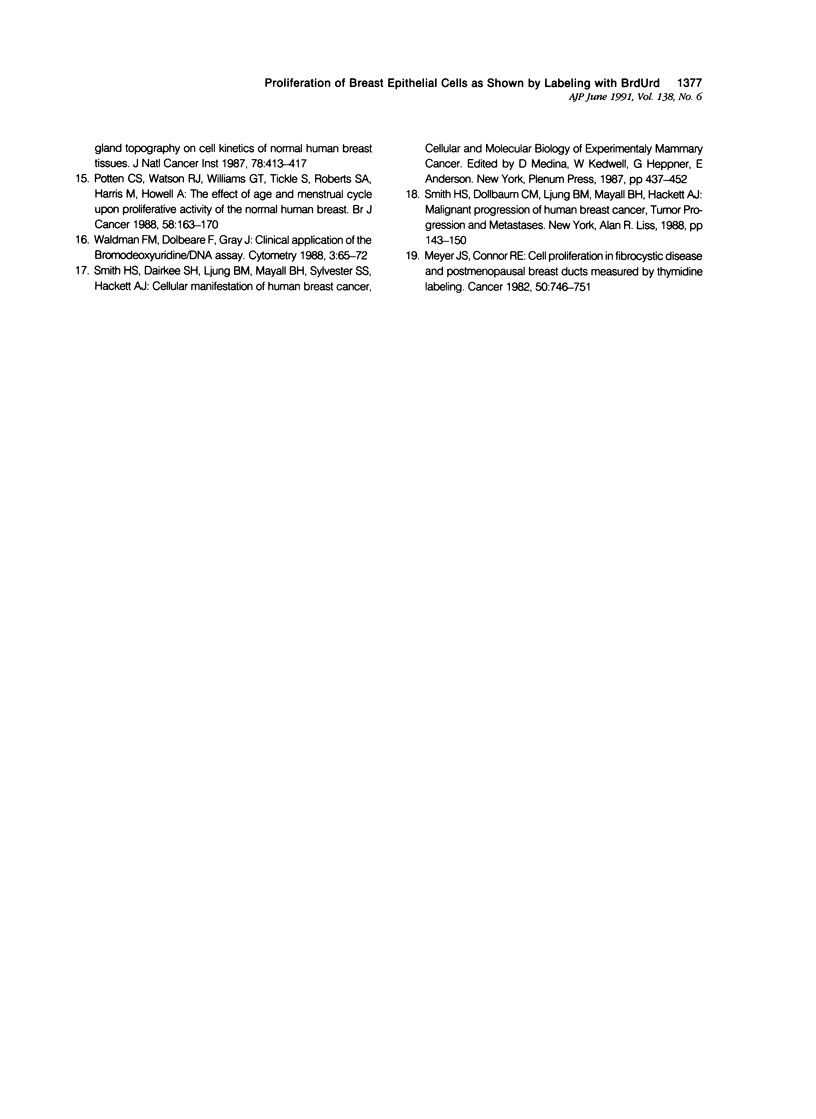
Images in this article
Selected References
These references are in PubMed. This may not be the complete list of references from this article.
- Anderson T. J., Battersby S., King R. J., McPherson K., Going J. J. Oral contraceptive use influences resting breast proliferation. Hum Pathol. 1989 Dec;20(12):1139–1144. doi: 10.1016/s0046-8177(89)80003-6. [DOI] [PubMed] [Google Scholar]
- Anderson T. J., Ferguson D. J., Raab G. M. Cell turnover in the "resting" human breast: influence of parity, contraceptive pill, age and laterality. Br J Cancer. 1982 Sep;46(3):376–382. doi: 10.1038/bjc.1982.213. [DOI] [PMC free article] [PubMed] [Google Scholar]
- Ferguson D. J., Anderson T. J. Morphological evaluation of cell turnover in relation to the menstrual cycle in the "resting" human breast. Br J Cancer. 1981 Aug;44(2):177–181. doi: 10.1038/bjc.1981.168. [DOI] [PMC free article] [PubMed] [Google Scholar]
- Going J. J., Anderson T. J., Battersby S., MacIntyre C. C. Proliferative and secretory activity in human breast during natural and artificial menstrual cycles. Am J Pathol. 1988 Jan;130(1):193–204. [PMC free article] [PubMed] [Google Scholar]
- Isola J. J., Helin H. J., Helle M. J., Kallioniemi O. P. Evaluation of cell proliferation in breast carcinoma. Comparison of Ki-67 immunohistochemical study, DNA flow cytometric analysis, and mitotic count. Cancer. 1990 Mar 1;65(5):1180–1184. doi: 10.1002/1097-0142(19900301)65:5<1180::aid-cncr2820650525>3.0.co;2-7. [DOI] [PubMed] [Google Scholar]
- Joshi K., Smith J. A., Perusinghe N., Monoghan P. Cell proliferation in the human mammary epithelium. Differential contribution by epithelial and myoepithelial cells. Am J Pathol. 1986 Aug;124(2):199–206. [PMC free article] [PubMed] [Google Scholar]
- Lellé R. J., Heidenreich W., Stauch G., Gerdes J. The correlation of growth fractions with histologic grading and lymph node status in human mammary carcinoma. Cancer. 1987 Jan 1;59(1):83–88. doi: 10.1002/1097-0142(19870101)59:1<83::aid-cncr2820590119>3.0.co;2-i. [DOI] [PubMed] [Google Scholar]
- Masters J. R., Drife J. O., Scarisbrick J. J. Cyclic Variation of DNA synthesis in human breast epithelium. J Natl Cancer Inst. 1977 May;58(5):1263–1265. doi: 10.1093/jnci/58.5.1263. [DOI] [PubMed] [Google Scholar]
- McGuire W. L. Prognostic factors for recurrence and survival in human breast cancer. Breast Cancer Res Treat. 1987 Oct;10(1):5–9. doi: 10.1007/BF01806129. [DOI] [PubMed] [Google Scholar]
- Meyer J. S. Cell proliferation in normal human breast ducts, fibroadenomas, and other ductal hyperplasias measured by nuclear labeling with tritiated thymidine. Effects of menstrual phase, age, and oral contraceptive hormones. Hum Pathol. 1977 Jan;8(1):67–81. doi: 10.1016/s0046-8177(77)80066-x. [DOI] [PubMed] [Google Scholar]
- Meyer J. S., Connor R. E. Cell proliferation in fibrocystic disease and postmenopause breast ducts measured by thymidine labeling. Cancer. 1982 Aug 15;50(4):746–751. doi: 10.1002/1097-0142(19820815)50:4<746::aid-cncr2820500420>3.0.co;2-a. [DOI] [PubMed] [Google Scholar]
- Potten C. S., Watson R. J., Williams G. T., Tickle S., Roberts S. A., Harris M., Howell A. The effect of age and menstrual cycle upon proliferative activity of the normal human breast. Br J Cancer. 1988 Aug;58(2):163–170. doi: 10.1038/bjc.1988.185. [DOI] [PMC free article] [PubMed] [Google Scholar]
- Silvestrini R., Daidone M. G., Di Fronzo G., Morabito A., Valagussa P., Bonadonna G. Prognostic implication of labeling index versus estrogen receptors and tumor size in node-negative breast cancer. Breast Cancer Res Treat. 1986;7(3):161–169. doi: 10.1007/BF01806246. [DOI] [PubMed] [Google Scholar]
- Tubiana M., Pejovic M. H., Koscielny S., Chavaudra N., Malaise E. Growth rate, kinetics of tumor cell proliferation and long-term outcome in human breast cancer. Int J Cancer. 1989 Jul 15;44(1):17–22. doi: 10.1002/ijc.2910440104. [DOI] [PubMed] [Google Scholar]
- Vogel P. M., Georgiade N. G., Fetter B. F., Vogel F. S., McCarty K. S., Jr The correlation of histologic changes in the human breast with the menstrual cycle. Am J Pathol. 1981 Jul;104(1):23–34. [PMC free article] [PubMed] [Google Scholar]
- Waldman F. M., Dolbeare F., Gray J. Clinical applications of the bromodeoxyuridine/DNA assay. Cytometry Suppl. 1988;3:65–72. doi: 10.1002/cyto.990090814. [DOI] [PubMed] [Google Scholar]



